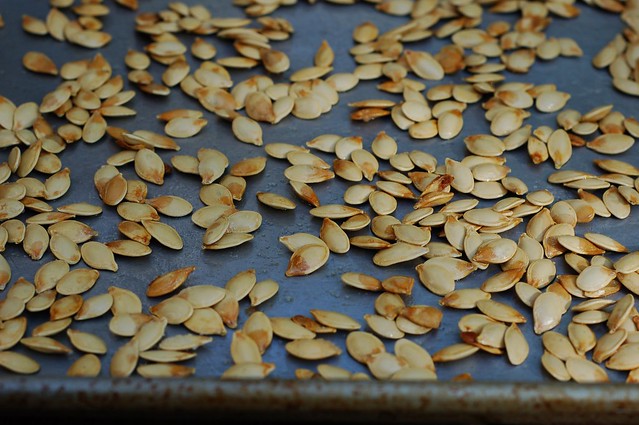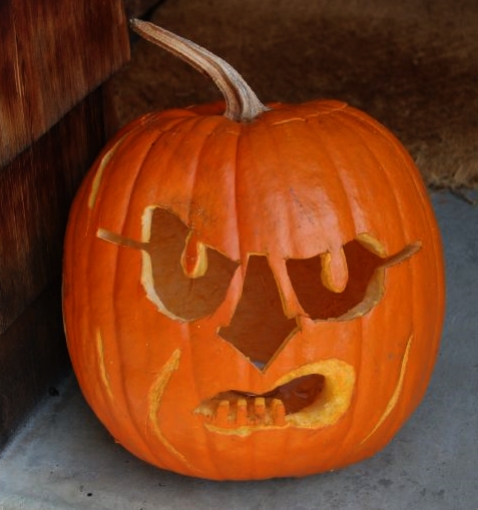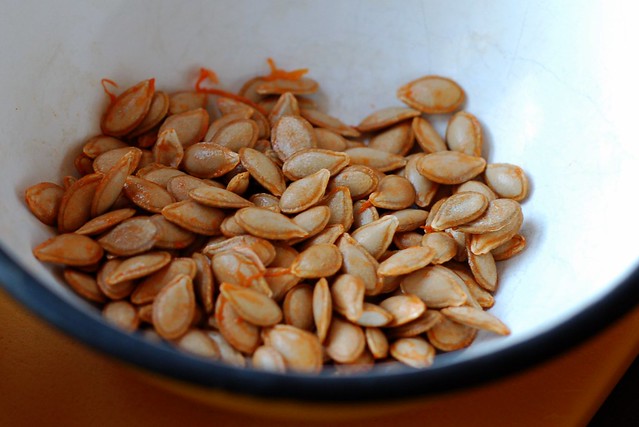The two friends had developed an interest in food and agriculture in college. After graduation, they moved to Greene, Iowa to find out where their food comes from. With the help of government subsidies, friendly neighbors, genetically modified seeds, nitrogen fertilizers, and potent herbicides they planted, grew and harvested a bumper crop of corn from a single acre of farmland. Curt's cousin, documentary-maker, Aaron Woolf, came along to direct this surprising exploration into our food system.
King Corn opens at Shattuck Cinemas in Berkeley this Friday, November 2nd. The film is also showing in many other cities around the country. Check http://www.KingCorn.net for theaters. Please go see it!
 EF: What surprised you most in making the film?
EF: What surprised you most in making the film?Curt: The most surprising part to me was the reality of farming. I had this pretty romantic notion of what life on a farm was like. Granted we were only growing one acre of corn, not hundreds or thousands of acres, but we really only farmed for a few hours and during those few hours we never really had to touch the dirt at all. It was amazing to me how divorced from the land our experience of farming was.
Ian: I agree with that. I was also surprised that the majority of the country's calories are stored in a few dozen buildings in the Midwest.
 EF: I was really shocked by the use of anhydrous ammonia as a fertilizer.
EF: I was really shocked by the use of anhydrous ammonia as a fertilizer.Curt: We were totally shocked. We actually went to an anhydrous ammonia factory (though it's not in the film). It's made by burning an incredible amount of natural gas. When Ian applied it to our acre before we planted our corn, one of the farmers, Rich, picked up a handful of the dirt and showed us a dead earth worm - and said, "You see here how applying the ammonia kills everything in a four inch swath." It was pretty unbelievable to us that the first act of farming was to kill all the living things in the soil. Seemed kind of counterintuitive.
Ian: That's not what Wendell Berry would do.
EF: Has this exploration changed your interpretation of the term “corn-fed”?
Curt: Very much so. It has this sort of wholesome connotation but it turns out that things that are corn-fed are really very far from wholesome.
EF: I loved all the stop-motion animations - how did you guys come up with the idea to do those?
Curt: Long, long Iowa winters with nothing to do at all except hang out in the basement and move little corn kernels around. I think that was Ian's idea and it ended up being really appropriate to the film because it has that sort of hand-made quality to it in the sense of we really were just trying to figure things out. Throwing glossy, digital effects in would have probably detracted from the experience. It was my childhood Fisher Price barnyard set and Ian's very affordable labor that made it all possible.
Ian: That Fisher Price barn totally reflects the mindset we had when we moved to Iowa in 2004. It was the perfect symbol of what we imagined agriculture to be -- the little red barn and the little animals and the two farmers. And, needless to say, that wasn't the reality at all.
EF: You credit Michael Pollan with being the inspiration for the movie. How did you first get introduced to his work?
Ian: We would read his essays in the New York Times Magazine in college. There was that wonderful article about his experience of buying a steer and following it through the food chain. I think that was undoubtedly an inspiration to us. He became an early advisor to the film. Curt and I were just about to embark on a cross-country research road trip and he advised us to take a good hard look at all the corn we saw along the way. I actually traded him my Masters thesis in exchange for him being our advisor.
Curt: I think we got the good end of that trade.
EF: The tasting scenes were some of my favorites in the film. What did the corn syrup that you two made taste like?
Curt: It tasted sweet and nasty. I don't know that we made it exactly right though we did our best. It's a pretty complicated process but we only had a Cuisinart and a saucepan. We actually tried making it again at the NPR studios last week and it turned out even worse that time.
Ian: I think the kicker was the final filtering process. As it was explained to us we needed to pour it through a pile of diatomaceous earth to filter it but I don't think it filtered through so much as dissolved so we were sort of drinking corn syrup and partially dissolved hardened sea creatures.
 EF: Did you feel uneasy about drinking something that you'd made with sulfuric acid?
EF: Did you feel uneasy about drinking something that you'd made with sulfuric acid?Curt: The NPR reporter (Robert Smith) certainly did!
EF: Were you surprised by the way your interview with Earl Butz (U.S. Secretary of Agriculture under Presidents Nixon and Ford) went?
Curt: On some level, yeah. We had learned enough by that point to really disagree with his policies and question them. All around us we could see the kind of landscape that his policies had created - giant industrialized farms and de-populated areas. So I think that we did walk into that room kind of wanting to challenge him and be mad at him but as soon as we met the guy we saw that of course he's just a normal person.
He's old and he had ideas that were very reasonable for his generation. When he graduated from college there was a great depression and when we graduated from college there was an obesity epidemic. So it makes sense both that he would want to make food more affordable and also that Ian and I would want to do something very different.
EF: Has this journey changed the way you eat?
Curt: Now that we know the back story to industrial food we're no longer comfortable with it but it is a real challenge to find good food. It's particularly hard right now because we're back on the road to promote the film so the gains we'd made in changing the way we eat have been largely eroded. It's frustrating that it's such a challenge to find something to eat that is not corn-based.
Ian: I'm a card-carrying member of the society that believes in convenient, affordable food. And I really want locally grown, healthful food to be available at my corner store. There are times when I love to play the part of the scavenger and spend a few days trying to find a turkey for Thanksgiving that was raised outside on a good diet but I'm coming to terms with the fact that, like many Americans, I don't want to spend all my time being a hunter-gatherer.
Curt: Ian did find and eat a pecan pie in a dumpster in college.
Ian: It was very convenient. I was already in the dumpster. Affordable, too.  EF: What was your goal in making this film?
EF: What was your goal in making this film?
Ian: I think my goal (beyond doing something with my then 22-year-old life besides sitting at a desk,) my hope was to tell a story about where our food comes from. I don't think we knew all the problems associated with the stories behind our food - all the communities that are affected, all the ways that agriculture takes a toll on the land and our health so we didn't start out with an agenda in that sense. And by the end of our experience we certainly didn't feel like we had a solution to all of  the problems we'd been encountering but more felt that the job of the film was to tell a story and hopefully spark some discussions and debates. I think we're really seeing that happen now as we take the film on the road and talk to people about these issues. Because, at the end of the day, there are a lot of ways of creating a better food system. There is no single solution. And that's actually very exciting and invigorating. The hope is that as people learn more about where their food comes from they'll make more informed decisions.
the problems we'd been encountering but more felt that the job of the film was to tell a story and hopefully spark some discussions and debates. I think we're really seeing that happen now as we take the film on the road and talk to people about these issues. Because, at the end of the day, there are a lot of ways of creating a better food system. There is no single solution. And that's actually very exciting and invigorating. The hope is that as people learn more about where their food comes from they'll make more informed decisions.
Curt: I think Ian has it right. It's incredible the number of people who've come up to us after seeing the film and have told us that they've changed the way they eat since watching it. And that was our hope - to transform the system into something that both tastes good and is good for you and the people who produce it.
EF: What’s next for you guys?
Curt: So far it's just been making sure that this film does some real good in the world. Right now that work is mostly in theaters so we've been on the road and will be traveling for the next month or two. Increasingly there are small grassroots screenings that are starting to get off the ground so we're starting to put our energy into the right way to do that. I think we're going to be fairly busy until April when the film will be broadcast on PBS.
Ian: I think that's about the size of it. We spent so long making the film that when we reached the finish line (or what we thought was the finish line) we all gave each other high fives and celebrated a job well-done. But then we woke up the next day and realized that there was a lot of work to be done to make sure the story got heard and made an impact. Hopefully, it won't take us quite as long to get the film out into the world as it did to make the film.







